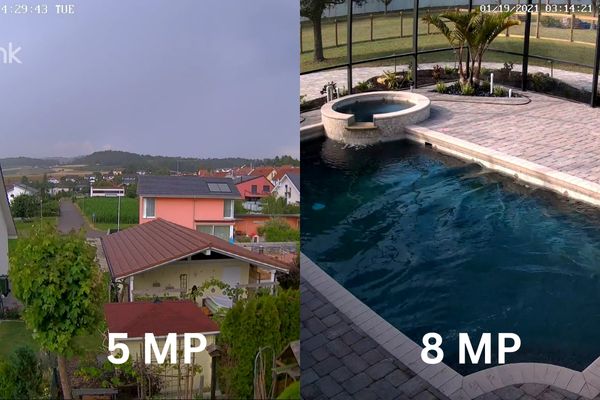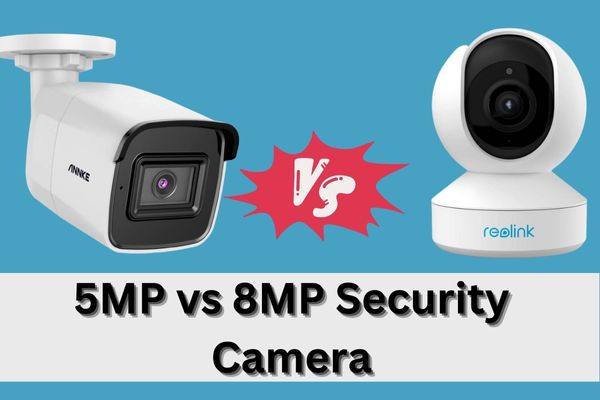Between 5MP vs 8 MP security camera, we know it’s tempting to incline towards higher pixel by inch, but does higher pixel translates to higher quality? Let’s decipher the myth of pixel war and unveil the truth in plain English.
As we all know, resolution determines the dimensions of a video. Videos with a lower resolution will have smaller images, while those with HD or high-definition will produce larger images. To put it simply, the larger the image, the higher the resolution and quality of the video. But the higher resolution doesn’t confirm a better-quality image whatsoever.
In this post, we’ll take a dummy’s look into the key differences between 5MP vs 8MP security cameras, from image quality to storage requirements; we’ll break down everything you need to know to help you decide. So, whether you’re a homeowner looking to beef up your home security or a property owner looking to protect your assets, keep reading to learn more.
5MP vs 8MP Security Camera Comparision Chart
Table of Contents
- 1 5MP vs 8MP Security Camera Comparision Chart
- 2 Major Similarities between 5MP vs 8MP Security Camera:
- 3 Major Dissimilarities between 5MP vs 8MP Security Camera:
- 4 5MP vs 8MP Security Camera: 7 Key Differences
- 5 How Many MP Should A Security Camera Have?
- 6 Does Bigger MP Mean Better Camera?
- 7 It’s The Verdict Time!
| Features | 5MP | 8MP |
| Image Quality | 1920p | 4K/2160p |
| Image Size | 2560*1920 | 3840*2160 |
| Pixels per Image | 5,017,600 | 8,294,400 |
| Aspect Ratio | 4:3 | 16:9 |
| Pixel Density | 5 million | 8 million |
| Frame Rate | 30 fps | 30fps/60fps |
Major Similarities between 5MP vs 8MP Security Camera:
When it comes to resolution for security cameras, 5MP and 8MP cameras are widely available. While there are differences between the two, they are similar in many aspects:
- Both 5MP and 8MP security cameras have high-resolution capabilities that provide clear and detailed images.
- Both can be connected to a network or used remotely via a mobile app or web interface.
- Both camera types have features like night vision, motion detection, and event recording.
- Both 5MP and 8MP security cameras support video compression standards such as H.264, H.265, and MJPEG.
- Both can be powered through PoE (Power over Ethernet), which simplifies installation.
- Both can store footage on a local hard drive or cloud-based storage service.
Major Dissimilarities between 5MP vs 8MP Security Camera:
Both 5MP and 8MP cameras can produce high-quality images, but there are some key dissimilarities between the two. 8MP cameras have higher resolution and larger sensors, which can lead to better image quality. Also, an 8MP camera typically has a larger sensor than a 5MP camera, which can lead to better image quality.
Other key dissimilarities include frame rate, storage, field of view, and more. Find the major dissimilarities you need to know between 5MP and 8MP security cameras below.
Related Posts: Best Cellular Security Cameras
5MP vs 8MP Security Camera: 7 Key Differences
1. Resolution:
A camera’s resolution is measured in megapixels (MP), the number of pixels in an image. The higher the resolution, the more detailed the image will be. A 5MP camera captures images at a resolution of 2560*1920 pixels, meaning that there are 5,000,000 pixels in the image. On the other hand, an 8MP camera captures images at a resolution of 3840*2160 pixels, producing a total of 8,294,400 pixels in the image.
The difference in resolution enables an 8MP camera to capture images with more detail and clarity than a 5MP camera. The additional pixels in the image provide a higher level of sharpness and definition, which is noticeable when the image is enlarged or cropped. The additional pixels provide more information for the image to maintain its quality.


2. Frame Rate:
A 5MP camera is capable of capturing 30 frames per second (fps). It means the camera can take 30 still images in one second. On the other hand, an 8MP camera may have a higher frame rate of up to 60fps, capturing 60 still images in one second.
A higher frame rate means the camera can capture more images in a shorter time, resulting in a smoother and more fluid feed. It’s particularly important for capturing fast-moving subjects or recording videos in high-action scenarios.
3. Image Quality:
4K (8MP) or Ultra-HD offers the clearest image quality, with almost twice as many pixels as 5MP, Super HD, or Quad HD. A 5MP security camera produces 5-megapixel images with 2560*1920 resolution, providing a high-definition image. On the other hand, an 8MP security camera offers even clearer images than a 5MP camera, and every additional pixel increases the image clarity.
4. Field of View (FOV):
8MP security cameras typically have a wider field of view than 5MP cameras. It means an 8MP camera can cover a larger area with a single shot. For example, the Amcrest 5MP Turret POE Camera has a FOV of 103°. In contrast, the Amcrest 4K IP PoE AI Camera UltraHD 8MP Security Outdoor Camera has a FOV of 129°
5. Bandwidth:
When it comes to security cameras, the amount of data that needs to be transmitted over the network, also known as bandwidth usage, is directly related to the resolution of the image produced by the camera. In general, an 8MP security camera will have a higher bandwidth requirement than a 5MP security camera.
Here’s a formula to calculate the required bandwidth:
Bandwidth (Mbps) = Bitrate (Main) * X + Bitrate (sub) *Y
X & Y in this formula represent the mainstream and the sub-stream number of your security camera. To determine the bitrate in this formula, you can check out your camera’s specifications or reach out to the security camera company’s customer care.
For example, if you have one security camera with a main-stream of 7144 kbps and another with a sub-stream of 512 kbps, the required bandwidth would be:
Bandwidth = 1 * 7144 kbps + 1 * 512 kbps =7656 kbps = 7.656 Mbps
In plain language, your required bandwidth will be 8 Mbps.
6. Storage:
Since 8MP cameras capture higher-resolution images, they require more storage space than 5MP cameras. So, you will need to invest in a larger-capacity storage device or a cloud-based storage service to store all images captured by an 8MP camera. In contrast, if you need basic surveillance, then 5MP is your best choice, as it takes less storage than an 8MP camera.
7. Price:
8MP security cameras are typically more expensive than 5MP cameras. 8MP cameras often come with a variety of additional features such as autofocus, image stabilization, and improved low-light performance; these features make the price higher of an 8MP security camera than a 5MP camera.
How Many MP Should A Security Camera Have?
The number of megapixels (MP) in a security camera refers to the resolution of the images it captures. A higher number of megapixels means that the images produced by the camera will be of higher resolution and contain detail. The number of MP a security camera should depend on the specific needs and application of the camera.
For example, for basic surveillance needs, monitoring a small area, or monitoring activity at a low-traffic location, a camera with 2-5 MP is sufficient. For more advanced surveillance needs, such as monitoring a large area or high-traffic location or capturing more detailed images, a camera with 8-12 MP is what you should be looking for.
Does Bigger MP Mean Better Camera?
The term “megapixel” refers to the number of pixels (tiny dots of color) that make up an image. The more pixels an image has, the more detailed and sharper it will appear. So, it would make sense to assume that a camera with a higher megapixel count would produce better-quality images, right?
Well, not necessarily. While a higher megapixel can produce sharper and more detailed images, other important factors, like lens quality, sensor size, and image processing capabilities, are also key factors in determining a camera’s performance.
For example, a camera with a lower megapixel count but a larger sensor size and high-quality lens will produce better-quality images than one with a higher megapixel count with a smaller sensor and lower-quality lens.
Additionally, software plays a role in image quality. For instance, a camera with advanced image processing capabilities may produce more natural and accurate colors even with a lower megapixel count. The story’s moral is that a higher megapixel count offers more details and clarity, but a bigger MP doesn’t mean a better camera.
It’s The Verdict Time!
Well, while deciding on a 5MP or an 8MP security camera, we recommend choosing based on your needs and budget. If you need a basic level of detail, field of view, and movement detection, you should go for a 5MP security camera. A 5MP security camera is adequate for residential or small commercial settings where the main focus is on overall surveillance, not details.
On the other hand, if you need a high level of detail, movement detection, and a wider field of view, an 8MP security camera is what you should choose. It’s best for larger commercial settings where the main focus is on specific details such as identifying individuals, license plates, or any specific object. So, decide wisely.

